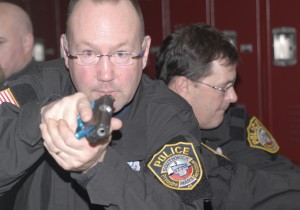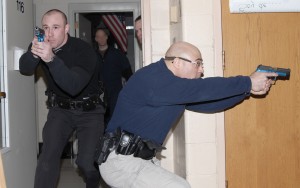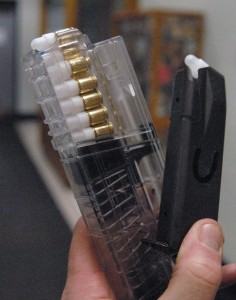 GRANVILLE – Granville Village School was turned into a training facility for local and state police this week.
GRANVILLE – Granville Village School was turned into a training facility for local and state police this week.
Members of the Southwick and Granville police departments trained with State Police for active shooter situations yesterday and again today.
With the school empty for winter break, police were able to simulate real-life situations and use hallways and classrooms for training.

“Active shooters are today’s reality,” said Southwick Officer Greg L. Burt. “The Southwick Police Department is committed to being ready to address the active shooter threat.”
State Police Sgt. Pardo Montagano said since the Newtown, Conn. tragedy, police departments across the Commonwealth are seeking more training in case of an active shooter.

“We do two or three a week,” Montagano said. “We do them all summer when school is out – we have been inundated with requests since Newtown.”
The State Police offers the training for free to police departments that request training. The only cost to departments is for 100 rounds of simunition (simulated ammunition).
This week was the second time the departments received the training. Last summer, a basic active shooter training was held at Southwick-Tolland-Granville Regional High School. This week the group of 20 officers received intermediate training. Montagano said there is also an advanced level active shooter training.
“Unfortunately, it’s all too common,” he said of incidents like the one at Newtown and Virginia Tech. “You never know what’s going to happen, and it may not be a school – it could be another building. It could happen anywhere.”
Police officers want to be prepared for any situation, he said.
“The more prepared officers are, the better the response,” Montagano said.
This training also included one dispatcher. Montagano said dispatchers are an essential part of active shooter response.
State Police directed the training by acting as role players in the force-on-force training. Officers were trained to navigate hallways, doorways, and open spaces.
Officers first trained on entry into the building and classrooms and were told to first use their instincts to show training troopers how they would respond. Troopers then offered suggestions for a better response and simulated several scenarios.
Training also included the use of simunition in real guns so police could have a more realistic training.
Montagano said the simunition, which is made completely of plastic, does sting when contact is made on skin, but does not hurt anyone.
Training for such situations has changed over the years, said Montagano. For instance, police were once trained to approach an active shooter situation as quietly as possible.
“Now we are trained to make as much noise as possible,” he said. “Sirens on and yelling – this takes the shooter’s focus and places it on us and away from the kids.”
Another change is that officers were once trained not to enter a building alone when a shooter is inside, but instead wait for backup.
“Now, you can’t wait,” Montagano said. “You have to go in by yourself. Waiting two minutes for backup is too long – a lot can happen in two minutes.”
Because officers are now trained to respond immediately, there is a greater likelihood an officer must fire a weapon.
“According to the FBI, one officer going into an active shooter situation has a 37-percent chance of discharging his weapon,” he said. “That is really high. Some officers go a year or two without discharging their weapon.”
The training is designed to create a skill set for the officers that will expedite the positive outcome of a real world situation for the children, staff, and visitors to the schools.

